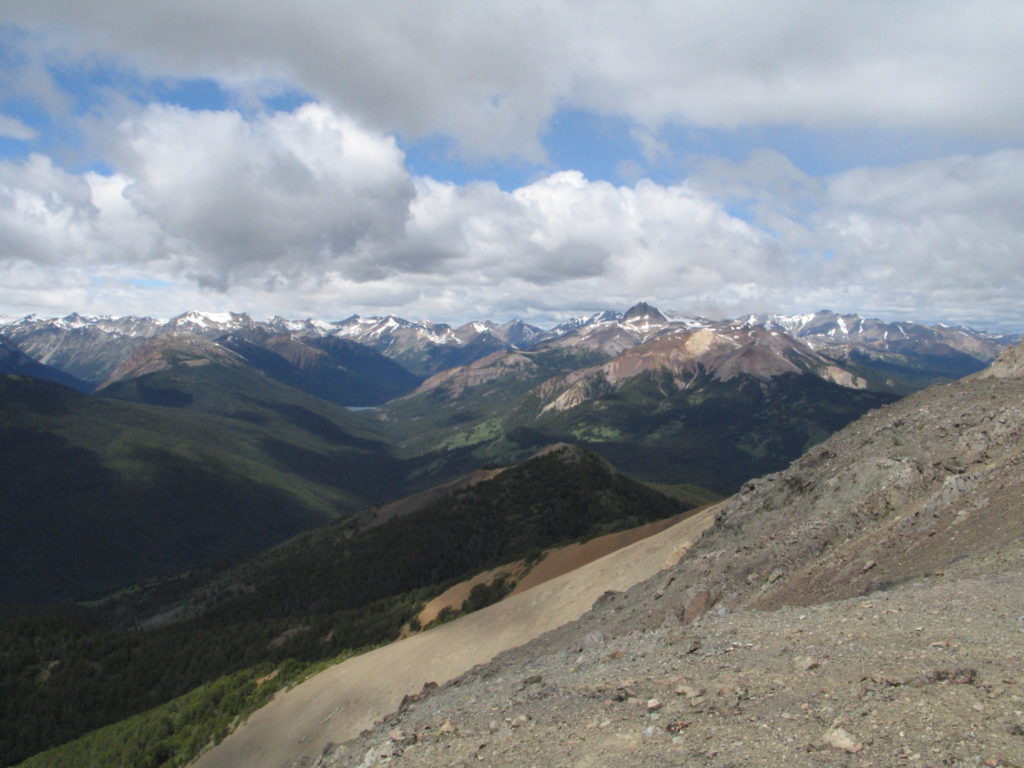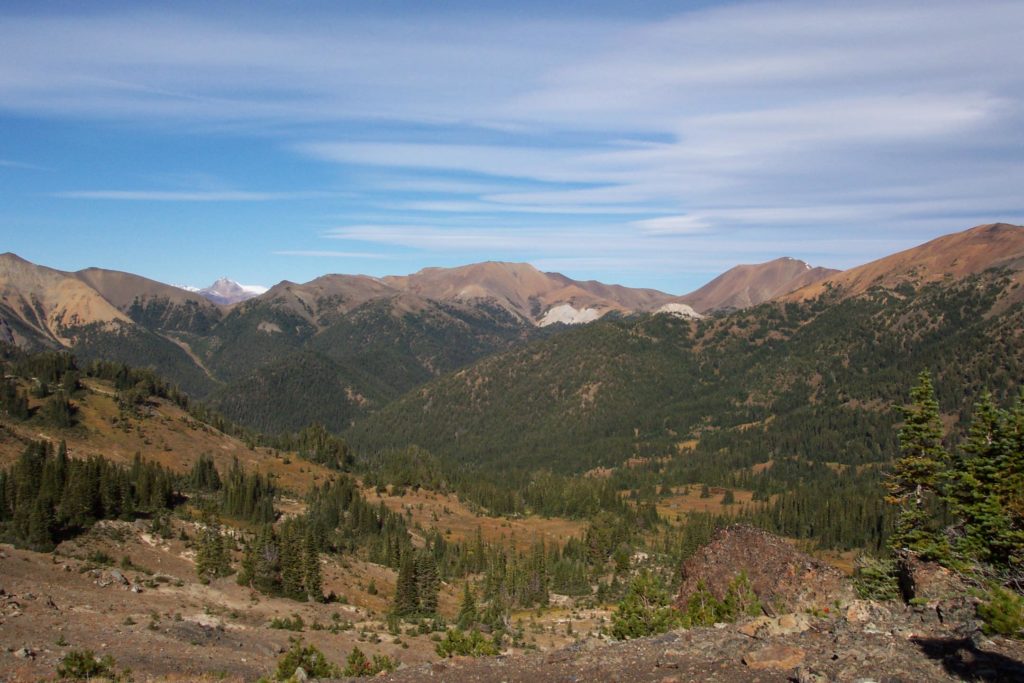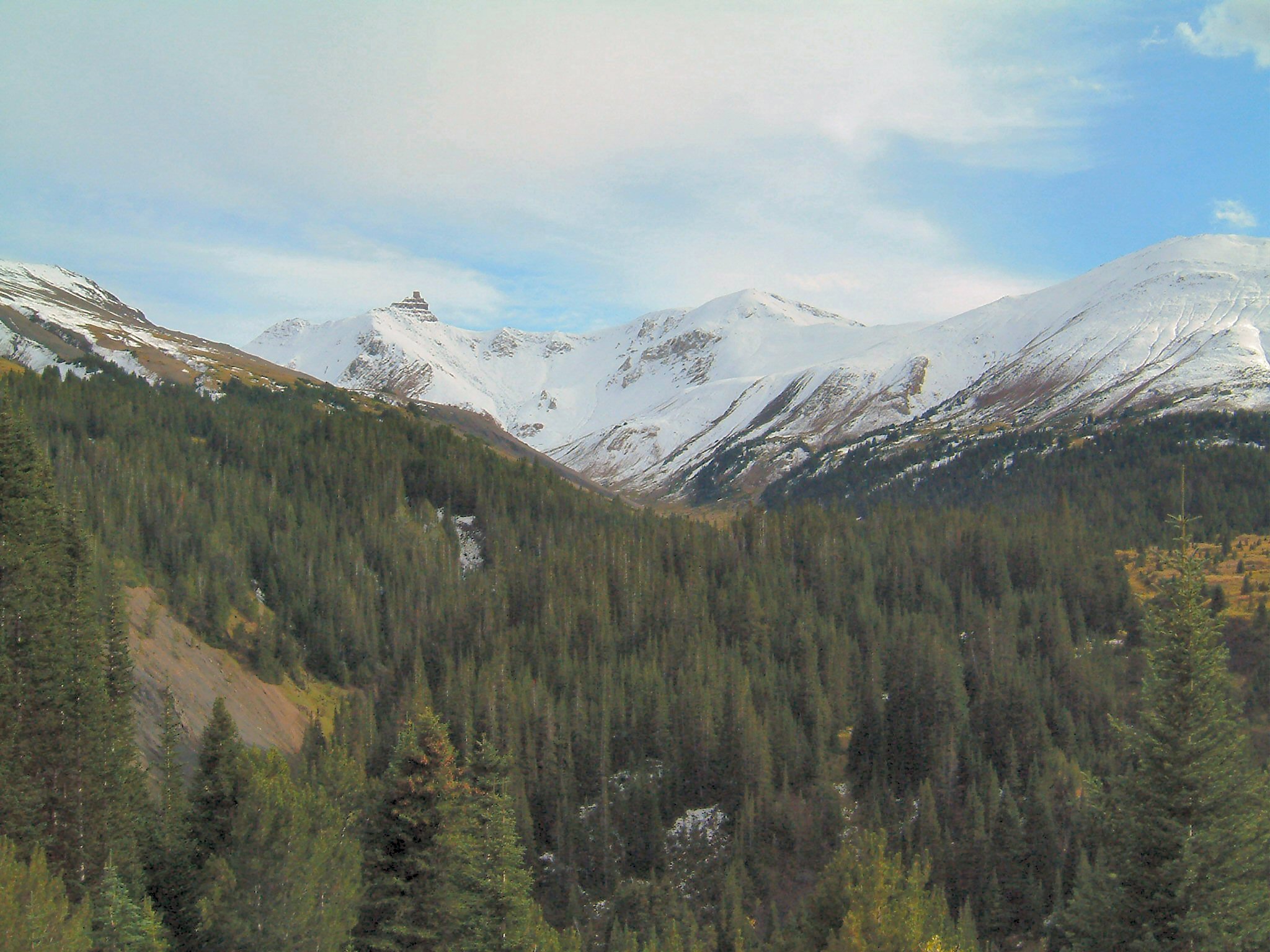The Chilcotin Ark has 12 of the 16 biogeoclimatic zones of British Columbia and due to that one of the highest biodiversities in British Columbia with a variety of wildlife and unique ecosystems. It is the only area in British Columbia where all 3 alpine zones meet each other.
Coastal Mountain-heather (CMA) Zone
Location: along the windward side of the Coast Mountains and mountains of the islands of coastal B.C.
Elevation: high elevations, starts at 1600 m in southern locations and 1000 m in northern locations
Climate: harsh, mean annual temperature 0º – 4ºC, mean temperature of warmest month below 10ºC, percipitation mostly as snow
Plants: no big trees but “krummholz, patches of stunted trees, dwarf willows, heather, sedges and rushes, variety of wildflowers
Wildlife: mountain goat, wolverine, marmot, Roosevelt elk, black-tailed deer, White-tailed Ptarmigan, Golden Eagle
Ecosystems: vegetation becomes sparse with elevation, treeline trees are subalpine fir, mountain hemlock, yellow-cedar and later on, patches of “krummholz”, as well as meadows to forage ungulates with a variety of wildflowers and rushes and sedges with beds of different types of heather, more diversity of plants where soil is deeper, in winter even mountain goats migrate into forested elevations due to the harsh enviroment and the amount of snowfall in this area
Interior Mountain-heather (IMA) Zone
Location: lee side of the south Coast Mountains, north Cascade Mountains, southern Rocky Mountains and Columbia Mountains
Elevation: high elevations, starts at 2500 m in southern locations and 1800 m in northern locations
Climate: harsh, mean annual temperature 0º – 4ºC, mean temperature of warmest month below 10ºC, summers are relatively warm compared to other alpine zones
Plants: no big trees but patches of stunted trees called“krummholz, dwarf willows, heather, rushes, sedges and lichen
Wildlife: mountain goat, bighorn sheep and caribou, mule deer, Rooseveltelk, grizzly bear
Ecosystems: vegetation becomes sparse with elevation, treeline trees are spruce and subalpine fir with lodgepole pine, white bark pine and alpine larch
higher vegetation is mostly evergreen dwarf shrubs like willow and mat-forming herbs, in summer and fall grizzly bear, mule deer and elk forage on the meadows
Boreal Altai Fescue Alpine (BAFA) Zone
Location: largest alpine zone, lee side of the north Coast mountains with boundaries including the Chilcotin Plateau, northern Rocky Mountains, Cassiar, Omineca and Skeena Mountains
Elevation: high elevations
Climate: harsh, mean annual temperature 0º – 4ºC, winter very long and cold, summers are short and cool with long days, mean temperature of warmest month below 10ºC
Plants: no trees, mostly dwarf willows and sedges, grasses and lichens
Wildlife: Stone sheep, caribou, mountain goat, grizzly bear, wolverine, grey wolf, marmot, Siberian lemming and arctic ground squirrel, Gyrfalcon, ptarmigans, Horned Lark, Blue grouse, Rosy Finch and Snow Bunting
Ecosystems: vegetation becomes sparse with elevation, in contrast with the other two alpine zones meadows contains primarily types of sedges, grasses, lichens, wildflowers and dwarf willows but no heather, windswept plateaus in this zone are important winter habitats for caribou, mountain goat and Stone sheep

Ponderosa Pine (PP) Zone
Location: southern B.C., along dry valleys as well as river valleys like lower Thompson, Similkameen, lower Kettle, Fraser (Lillooet area) and Nicola
Elevation: low elevations, 335 – 900 m
Climate: driest forested zone in B.C., low precipitation, most of it falls in winter, summers are one of the warmest, mean temperature in warmest month ranges between 17º and 22ºC
Plants: dominant tree is Ponderosa pine, sometimes Douglas-fir as well, variety of shrubs and grasses
Wildlife: white-tailed and mule deer, Bighorn sheep, Rocky Mountain elk, lot of different birds like Brewer’s Sparrow and Thrasher, coyote, black bear, cougar, muskrat, beaver, badger, marmot
Ecosystems: savanna like, sometimes close to open forests with mostly Ponderosa pine, sometimes Douglas-fir on more moist sites, are winter habitats for elk, Bighorn sheep,white-tailed and mule deer as well as numerous birds, due to location between Great Basin in the south and boreal forest in the north some birds like Gyrfalcon and Snowy Owl have their southern migration limit in this area and other like Canyon Wren have their northern migration limit here, also the breeding habitat of endangered bat species,
wetland meadows and ponds are home to variety of insects, amphibians and reptiles, fire occurs every 15-20 years and only burn understory, Ponderosa Pine bark is especially thick to protect the tree from burning
Mountain Hemlock (HM) Zone
Location: everywhere along B.C. Coast and Coast Mountains, extents into the USA north and south of B.C., located between Coastal Western Hemlock and Alpine Tundra Zones
Elevation: sub-alpine elevations, 900-1800 m in southern locations, 400-1000m in northern locations
Climate: cool and short summers, long, cool and wet winters, one of the wettest zones, up to 5000 mm precipitation, most of it falls as snow, short growing season due to deep snow pack
Plants: mountain hemlock, yellow-cedar, redcedar, western hemlock, Sitka spruce, variety of shrubs like blueberry, false azalea or huckleberry, mosses
Wildlife: Roosevelt elk, grizzly and black bear, mountain goat, Great Grey Owl, Great Horned Owl, different woodpecker
Ecosystems: forest tree species differ between elevation and moisture of the locations , i.e. moist, lower elevation forests contain mostly yellow-cedar and mountain hemlock, in the northern parts Sitka spruce is occurring often as well, undercover is full of dense shrubs, ground is covered with various and thick mosses, grizzly bears build their hibernation-den in the zone, the old forests are home of variety of birds due to amount of food available, bears and Roosevelt elk range on the meadows and wetlands in the zone
Coastal Western Hemlock (CWH) Zone
Location: along the coastline of B.C. and Coast Mountains, spreads into major river valleys
Elevation: lower elevations
Climate: moderate temperatures, cool summers and mild winters, one of the wettest zones
Plants: conifers like western hemlock and western redcedar, yellow-cedar, mountain hemlock, variety of mosses
Wildlife: grizzly and black bear, black-tailed deer, grey wolf, salmon, diversity of coastal birds
Ecosystems: old growth forests with a sparse herb layer but a thick moss carpet, due to the amount of precipitation nutrients get washed out of soils quickly that’s why organic matter in the soil hold most nutrients, shoreline is nesting habitat for many different coastal birds like Tufted Puffins, Auklets, Murrelets, forests provide winter habitat for black-tailed deer and the rich rivers provide food for bears, grassland is uncommon in the zone
Montane Spruce (MS) Zone
Location: south interior of B.C. Expands from the Fraser Plateau south into the USA
Elevation: mid elevations between the ESSF, SBPS and IDF Zone, 1100-1500 m in wetter climate areas and 1250-1650 m in drier climate
Climate: cool climate, short,warm and dry summers and cold winters, 5 months per year mean temperature is below 0ºC, low precipitation (300-900 mm per year), most of it as snow
Plants: Subalpine fir, hybrid (Engelmann x white) spruce, Douglas-fir, lodgepole pine, trembling aspen, western larch, variety of berries, mosses and small flowers
Wildlife: caribou, moose, mule deer, Bighorn Sheep, mountain goat, birds like woodpecker, Pine Grosbeak, marten, pika and ground squirrel
Ecosystems: is a transition zone between the higher elevated ESSF zone and the lower elevated SBPS and IDF zone, forests are full of different tree species from neighboring zones like subalpine fir, lodgepole pine, hybrid spruce or Douglas-fir, as well as a mixture of typical understory plants from neighboring zones like gooseberry and huckleberry, as well as soopollalie berry and juniper and some small flowers, vegetation is affected by frequent wildfires, hybrid spruce and subalpine fir are the main tree species of the zone but rarely dominate due to the fires, results in lonely standing of mature lodgepole pine and Douglas-fir, open forests and wetlands are important summer and fall habitat for mule deer and moose, drier locations, where lichens cover the ground, are good winter habitat for caribou, southern facing slopes and dry grassland offer range for Bighorn Sheep and mountain goat, pika and ground squirrel make their dens on those slopes, the variety of trees are perfect habitat for variety of birds
Bunchgrass Zone (BG)
Location: central and southern interior, along major river valleys in the Okanagan, Fraser river (north of Lillooet), Thompson river (around Kamloops) and Similkameen
Elevation: from valley bottom up to 900 m
Climate: one of the driest and warmest zones, warm to hot summers and moderately cold winters, low precipitation, some parts get no snow at all
Plants: trembling aspen, ponderosa pine, Douglas-fir, variety of grass like bluebunch and Sandberg’s wheatgrass, shrubs and forbs like big sagebush, antelope bush
Wildlife: variety of bats like pallid bat and Townsend’s big eared bat, Burrowing Owl, Rocky Mountain elk, Bighorn Sheep, mule deer, white-tailed deer, different woodpeckers, sharp-tailed grouse, badger
Ecosystems: mostly grassland with widely spaced bunchgrass like the dominant bluebunch wheatgrass and Sandberg’s bluegrass and drought-tolerant forbs and shrubs like big sagebush on lower elevations, soil between bunchgrass is covered with variety of lichens, mosses and bacteria (cryptogamic crust), helps to hold soil surface together and protects it from erosion, grassland is habitat for birds like the Burrowing Owl and sharp-tailed grouse, reptiles and small mammals as well as winter habitat for Rocky Mountain elk, mule deer, white tailed deer, Bighorn sheep, Gyrfalcon and Snowy Owl, most areas in the zone are too dry for trees, on steep rocky soils and more moist areas, forests of Douglas-fir and ponderosa pine occur, around the wetlands and on very moist locations tall shrubs and trembling aspen grow with an undercover of western snowberry and roses, forest areas are the home of a variety of woodpeckers like White-headed and Lew’s Woodpecker as well as bats,
also home of many endangered species like badger, Sage Thrasher and western rattlesnake
Engelmann Spruce-Subalpine Fir (ESSF) Zone
Location: most southern interior B.C. except the big interior plateaus,
Elevation: uppermost forested elevations, 1200-2300 m in southern areas and 900-1700 m in northern areas
Climate: short cool summers with mean temperatures above 10ºC in two months and long cold winters with snow conditions for up to 7 months per year
Plants: Engelmann Spruce, subalpine fir, whitebark pine, lodgepole pine and alpine larch, diversity of berries like Blueberry, grouseberry, saskatoon berry, huckleberry, heather
Wildlife: black and grizzly bear, moose, mountain goat, caribou, mule deer, wolverine, marten, fisher, seed-eating birds like Clark’s Nutcracker, Pine Siskin and Red Crossbill, Gold Eagle
Ecosystems: forests in lower and mid elevation contain mostly subalpine fir and Engelmann spruce which dominates the canopy, in high elevation and wetter locations subalpine fir dominates, berry shrubs grow as understory and are food resource for bears, moose, marten, wolverine, fisher and mule deer in the spring and summer time as well as a variety of seed-eating birds, on higher elevations trees stand in small groups surrounded by meadows, grassland and heath, which is the winter habitat for caribou and mountain goat, whitebark pine and alpine larch grow in higher elevation, close to treeline patches of stunted trees, “krummholz” appear, meadows are full of a variety of wildflowers and home of ground squirrels and marmot

Sub-Boreal Pine-Spruce (SBPS) Zone
Location: central interior B.C., Fraser Plateau and Nechako Plateau, extends into lower mountain ranges around the plateaus
Elevation: mid elevations, 850-1300 m in northern locations and up to 1500 m in southern locations
Climate: cold and dry winter with cool and dry summer, low precipitation all year round with 335-580 mm, low air moisture
Plants: Lodgepole pine, trembling aspen, Douglas-fir, white spruce, Engelmann Spruce, soopallalie, kinnikinnick, common juniper, different grass species and lichen
Wildlife: caribou, moose, black and grizzly bear, beaver and muskrat, small mammals like squirrels, seed or insect eating birds like Brown Creep, red-breasted Nuthatch and Boreal Chickadee, Spruce and Ruffed Grouse, waterbirds like loon, Canada Goose, Sandhill Crane
Ecosystems: two major ecosystems forests and wetland, forests are dominated by lodgepole pine, some parts only contain lodgepole pine as canopy, understory contains common juniper,pine grass, kinnikinnick soopalalie and lichens, forests are habitat for variety of birds as well as small mammals, some parts are important winter habitat for caribou, on more moist location around the wetlands small Engelmann spruce, white spruce and trembling aspen occur with mosses, grey-leaved willow and variety of berries as understory, wetlands are dominated by mosses and sedges and are important habitat for bears, moose, beaver and muskrat as well as water birds, the only nesting colony of white pelican in B.C. occurs in this zone, on needlegrass covered south facing slopes near the IDF zone Douglas-fir grows,
Sub-Boreal Spruce (SBS) Zone
Location: interior plateau of B.C., Nechako plateau, Fraser plateau, Quesnel plateau and into river valleys
Elevation: from valley bottoms up to 1300 m
Climate: continental climate with short, warm summer and long cold winter and extreme temperatures from up to 30ºC in summer and down to -40ºC in winter, moderate precipitation with 440-900 mm per year
Plants: hybrid white spruce, lodgepole pine, subalpine fir, douglas fir, different willows, scrub birch, variety of berries like blueberry, bunchberry, thimbleberry, huckleberry, cranberry, lillies, devils clubs, ferns,
Wildlife: moose, grey wolf, grizzly bear, ermine, fisher, marten, variety of water birds like Barrow’s Goldeye and seed eating birds like Pine Grosbeak, Pine Siskin, Golden-crowned Kinglet, Great Horned Owl, Great Grey Owl
Ecosystems: forested area in the northern part contain mostly hybrid white spruce and subalpine fir, understory is full of variety of plants like blueberry, ferns, Devil’s club and lillies, on drier sites Douglas-fir and lodgpole pine are the main tree species and understory is packed with blue- and huckleberry and kinnikinnick, habitat for variety of seed eating birds like Pine Siskin, Golden-crowned Kinglet and Pine Grosbeak, with most birds using the zone as nesting and summer habitat and migrate away in winter, as well as smaller predators like marten, fisher and ermine and predatory birds like Great Grey and Great Horned Owl,
different willows, scrub birch and sedges are growing around wetlands as well as hybrid white spruce in more forested areas, habitat for moose, grizzly bear and the Barrow’s Goldeneye
Interior Douglas-fir (IDF) Zone
Location: southern part of interior plateau, southern part of the Cariboo and Chilcotin, up into Coast Mountain slopes, eastern valleys in Thompson region, Okanagan-Similkameen
Elevation: low to mid elevation, 400-1400m
Climate: short, warm and dry summer with cool winter, second warmest forested zone, lays in rainshadow of Coastal mountains
Plants: Douglas-fir, ponderosa pine, lodgepole pine, trembling aspen, different grasses like pinegrass, bluebunch wheatgrass and junegrass, saskatoon, soopalallie and snowberry, kinnikinnick,
Wildlife: mule deer, white-tailed deer, Bighorn Sheep, Rocky Mountain elk, Great Blue Heron, insect eating birds like Northern Flicker, Pileated Woodpecker and Red-breasted Nuthatch, seed eating birds like Clark’s Nutcracker and Red Cross-bill, Badger,
Ecosystems: most forests dominated by Douglas-fir with pinegrass, kinnikinnick and soopallalie as well as other berry shrubs as understory, drier locations are more grassland with bluebunch wheatgrass and junegrass or more open ponderosa pine forests i.e. south facing slopes, important winter habitat for mule and white-tailed deer, Bighorn Sheep and Rocky Mountain elk and habitat for Red-tailed Hawk and Golden Eagle, on higher elevation lodgepole pine is common tree in open forests, habitat for pika, marmot and chipmunk and their predators, Golden Eagle and Red-tailed Hawk, wetlands in the zone are surrounded by trembling aspen, willows and sedges, habitat for reptiles, amphibians and water birds like Great Blue Heron, bears, moose, mule and white-tailed deer also range in wetlands
